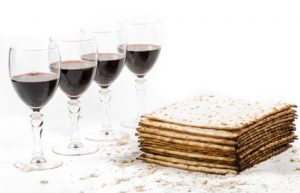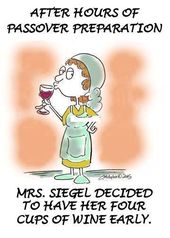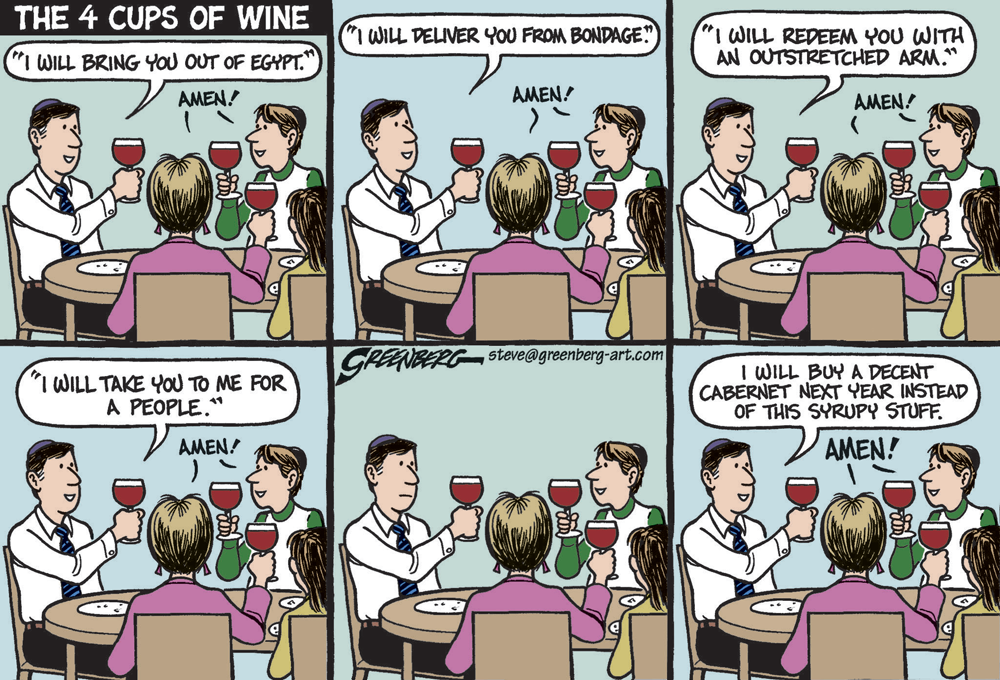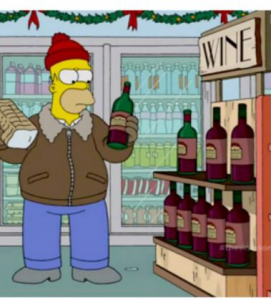
The weeks leading up to Pesach are the US kosher wine industry’s busiest, with more kosher wine purchased during this period than the rest of the year combined. In Israel, Rosh Hashanah is nearly as busy a buying season as Pesach and wine buying is also more liberally spread out through the year. Even though the more than 3,500 different kosher wines being produced annually includes almost 100 disparate varieties of Fake Wines like Kedem Malaga, Manischewitz, variations of Yayin Patishim and of course the Blue Bottle Abomination, there remain far too many labels for any sane human being to wade through.
Elevated Stress Levels
 I often discuss the many benefits of kosher wine proliferation; but the enhanced stress levels brought on by cooking commercial grade levels of brisket and matzah balls while attempting to eradicate every speck of dirt from the inside of your oven with a toothbrush highlight one of the few negative aspects of this bounty. With wine such an integral part of the Pesach experience, the massive amount of choices can create a particularly stressful shopping experience as one contemplates the near-endless number of choices on the shelves or webpage of your favorite retailer. Exacerbating the issue are several mitigating circumstances including the sheer number of mediocre-at-best available wines (along with an acceptable amount of true drek) and the unfortunate tendency of many retailers to part you from your hard earned krona by selling these less than worthy wines. Typically stemming from a lack of knowledge, occasionally more sinister reasons are at play so, like in any other transaction, caveat emptor. Other aggravating obstacles include lack of vintage transparency and the oenophilic “bait and switch” – advertising great deals for allocated wines without having them in stock and then selling you copious amounts of sub-par wines. Adding to the fun is the terrible fact that many stores and online purveyors continue to sell wines that are so far past their optimum drinking windows that it’s practically criminal.
I often discuss the many benefits of kosher wine proliferation; but the enhanced stress levels brought on by cooking commercial grade levels of brisket and matzah balls while attempting to eradicate every speck of dirt from the inside of your oven with a toothbrush highlight one of the few negative aspects of this bounty. With wine such an integral part of the Pesach experience, the massive amount of choices can create a particularly stressful shopping experience as one contemplates the near-endless number of choices on the shelves or webpage of your favorite retailer. Exacerbating the issue are several mitigating circumstances including the sheer number of mediocre-at-best available wines (along with an acceptable amount of true drek) and the unfortunate tendency of many retailers to part you from your hard earned krona by selling these less than worthy wines. Typically stemming from a lack of knowledge, occasionally more sinister reasons are at play so, like in any other transaction, caveat emptor. Other aggravating obstacles include lack of vintage transparency and the oenophilic “bait and switch” – advertising great deals for allocated wines without having them in stock and then selling you copious amounts of sub-par wines. Adding to the fun is the terrible fact that many stores and online purveyors continue to sell wines that are so far past their optimum drinking windows that it’s practically criminal.
Help is Here
 Given my belief that wine’s primary purpose as a beverage is to bring pleasure, I have done the work for you and curated my Annual Pesach Kosher Wine Buying Guide from among all the various options out there. Hopefully the Guide will simplify your wine shopping and allow you to get back more important holiday preparations like peeling 3 metric tons of potatoes and making sure your family has enough Kosher for Passover diet Coke to last a lifetime.
Given my belief that wine’s primary purpose as a beverage is to bring pleasure, I have done the work for you and curated my Annual Pesach Kosher Wine Buying Guide from among all the various options out there. Hopefully the Guide will simplify your wine shopping and allow you to get back more important holiday preparations like peeling 3 metric tons of potatoes and making sure your family has enough Kosher for Passover diet Coke to last a lifetime.
Following last year’s enhancement, the Guide covers my top recommendations for wines in the following five price tiers: (1) Under $18, (2) between $18-29.99, (3) between $30-49.99, (4) Over $50 and (5) Moshiach Wines. As most of my readers know, Moshiach Wines are wines that I would proudly serve the Moshiach, were I ever sufficiently deserving for him to grace my Seder table.
Many of the wines on this list will not come as a surprise to my regular readers given their perennial appearance over the years resulting from the consistent excellence of their producers and the talent of the applicable winemaker. As years go by and the quality and quantity of top-notch kosher wines grows, the potential wines for this list gets longer, increasing the difficulty in providing this highly-curated list (listing every good wine would defeat the entire purpose of the list). Representing less than 5% of all commercially available kosher wines, the list should go a long way in easing the pain of sifting through all your options. For those desiring further curating, next week’s edition will also include a few of my personal favorites from each of the five price ranges. With the quality of white wines increasing year over year there are more white wines on the list than in prior years, especially on in the lower price ranges. If you are one of those unfortunate and self-proclaimed “I don’t drink white wine” people, please take this as an opportunity to try something new – I promise you won’t be disappointed.
The Fine Print
 As a deal lawyer with nearly 20 years of practice under my belt, it shouldn’t surprise anyone that a list of this magnitude comes with some fine print and a few important caveats.
As a deal lawyer with nearly 20 years of practice under my belt, it shouldn’t surprise anyone that a list of this magnitude comes with some fine print and a few important caveats.
1. The Guide isn’t intended to be a comprehensive list of every wine I believe worthy of your consideration. It represents a selection of the better wines available across different pricing tiers; each of which I recommend and believe worthy of your Pesach table. As you all know, I only write about wines I like and you can therefore safely purchase any wines previously recommended, even if they aren’t on this list, including last year’s guide (as I tried not to repeat wines like most of the 2015 Bordeaux wines). Of course, any such wines remain subject to their recommended drinking window.
2. Broadly speaking, the majority of wines from ElviWines, Flam, Gvaot, Hajdu, Recanati and Tzora are worth buying, even if they aren’t listed below. Additionally, many of last year’s wines are still available on the shelves and remain in top drinking condition so check out last year’s list for additional suggestions and/or vintages.
3. Some wines may only be available either in Israel or the US and are marked as such. While there remain a number of wines that remain available only in their country of production (e.g. Four Gates, Hajdu and Shirah in the US and Mia Luce in Israel), the vast majority of recommendable Israeli wines are imported to the US these days (Shmita excepting) and most of the Herzog/Royal wines that were formerly “US Only” wines, are exported to Israel, making this list more useful across the broadly disparate geographic location of my 11,000 readers.
4. Due to the disparate geographical disbursement of my reader base, the listed vintages may be different depending on which part of the world your shopping cart is located in (although vintages tend to also shift from local retailer to retailer and distributor to distributor, depending on how much of the prior vintage they have left in stock). Especially for Israeli wines, different vintages are available in Israel and outside of Israel.
5. It is always best practice to consult me before buying a recommended wine from a different vintage but in this case, given the fluctuation in quality of recent vintages and potential shipping/storage issues, I’d be even more careful than usual when utilizing this list to purchase non-listed vintages.
6. Prices can fluctuate wildly among the various markets so I average to determine the tier each wine falls into. However, listed wines in your local market may not always fall exactly within the listed price points (online price-checking is always a good idea as is asking retailers to match listed prices).
7. To ensure the practical functionality of this list, I have not included wines only available to wine club members (e.g. Herzog’s Valhall Single Vineyard Cabernet Sauvignon of Hagafen’s Prix Reserve Cabernet Franc) and have significantly reduced the number of listed wines that aren’t generally available (Mia Luce from the 2016 vintage onwards) or have sold out (e.g. the 2016 Chateau Larcis Jaumat and most of the Four Gates wines).
Seder Drinking Conundrum
 Despite being at the top of any listing of an oenophile’s favorite customs, the tradition to consume four full cups of wine at the Seder brings a host of problems whose solutions can require a bit of advance thought and careful planning.
Despite being at the top of any listing of an oenophile’s favorite customs, the tradition to consume four full cups of wine at the Seder brings a host of problems whose solutions can require a bit of advance thought and careful planning.
First and foremost is that four cups of is a lot of wine to consume at one sitting (even for a five hour traditional Seder), especially given the fact that the first two cups are typically imbibed on an empty stomach. Another issue stems from the tradition of using a silver goblet for Kiddush (and the rest of the cups). While the easy solution of pouring the wine into a proper wine glass immediately following the recital of Kiddush works beautifully on a regular Shabbat or holiday, the lengthy Hagada ensures far more contact with the silver during the Seder. Other issues are caused by the common traditions of using only red wine and avoiding mevushal wines during the Seder.
With the Seder representing one of the most important meals on the Jewish calendar, people try to have the nicest (and typically the most expensive) wines possible, creating yet another potential conundrum. Despite being among the kosher wine world’s best, the top tier Bordeaux, Israel and California wines are not going to be properly appreciated giving the hurried manner in which most of the Seder’s four cups are mandated to be consumed. Many of the better wines are full-bodied, oak aged and boldly flavored; attributes not very conducive to Seder drinking. Between the empty stomach with which most people approach the first two cups, the halachic requirement to consume nearly an entire cup of wine rather rapidly and the need to keep a roomful of over-stimulated children from re-enslaving us all; most Sederim offer far-from-ideal conditions for enjoying such magnificent wines.
The Perfect Solution
 Therefore, I suggest saving the more expensive wines for leisurely drinking during Shulchan Aruch (i.e. the actual meal) and the plethora of subsequent holiday meals while finding other worthy options for the four cups. Being a traditionalist, my personal custom is sticking with red wines for all four cups (while Rosé is a terrific compromise on all fronts, only a handful of 2018 Rosés have hit the market and 2017 versions should be avoided), while using a few basic principles to choose the proper wines. Despite the less than adequate conditions mandated by our traditions, Seder night is one of the most exalted evenings we get to spend in G-d’s company, while celebrating our freedom from oppressive slavery and the coalescing of the Jewish People into a nation with collective responsibility for one another. As such top quality wine is still a pre-requisite. The tradition of large family gatherings that started with the first Seder continues unabated today, often resulting in a widely disparate range of palate preferences. Given the large numbers, to satisfy all comers (and to avoid fielding the inevitable questions about the horrid blue bottled abomination), I focus on affordable medium bodied quality wines that are highly approachable and enjoyable even without any oenophilic sophistication. Over the years, my “go-to” Seder wines have included Israeli Petite Sirah from Dalton and Recanati, entry-level Spanish wines from Capcanes (e.g. Peraj Petita) and ElviWines (e.g. Rioja Crianza and “semi-Crienza”). To the extent you are looking for well-priced and versatile white (or Rosé); good bets will be Rosé from Netofa, Recanati and Dalton, Sauvignon Blanc from Yarden, Covenant and Goose Bay, Pinot Grigio from Yarden and Dalton, Jacques Capsouto’s Blanc and Rieslings from Carmel (Kayoumi) and Kishor.
Therefore, I suggest saving the more expensive wines for leisurely drinking during Shulchan Aruch (i.e. the actual meal) and the plethora of subsequent holiday meals while finding other worthy options for the four cups. Being a traditionalist, my personal custom is sticking with red wines for all four cups (while Rosé is a terrific compromise on all fronts, only a handful of 2018 Rosés have hit the market and 2017 versions should be avoided), while using a few basic principles to choose the proper wines. Despite the less than adequate conditions mandated by our traditions, Seder night is one of the most exalted evenings we get to spend in G-d’s company, while celebrating our freedom from oppressive slavery and the coalescing of the Jewish People into a nation with collective responsibility for one another. As such top quality wine is still a pre-requisite. The tradition of large family gatherings that started with the first Seder continues unabated today, often resulting in a widely disparate range of palate preferences. Given the large numbers, to satisfy all comers (and to avoid fielding the inevitable questions about the horrid blue bottled abomination), I focus on affordable medium bodied quality wines that are highly approachable and enjoyable even without any oenophilic sophistication. Over the years, my “go-to” Seder wines have included Israeli Petite Sirah from Dalton and Recanati, entry-level Spanish wines from Capcanes (e.g. Peraj Petita) and ElviWines (e.g. Rioja Crianza and “semi-Crienza”). To the extent you are looking for well-priced and versatile white (or Rosé); good bets will be Rosé from Netofa, Recanati and Dalton, Sauvignon Blanc from Yarden, Covenant and Goose Bay, Pinot Grigio from Yarden and Dalton, Jacques Capsouto’s Blanc and Rieslings from Carmel (Kayoumi) and Kishor.
Parting Advice
During this busy buying season, retailers pull out all the stops to bring in your dollars with big sales everywhere. Between the increasing competition and online availability of most top-notch kosher wines, most wine merchants will match any published price, so always ask your favorite retailer to match the prices you have seen elsewhere and, if you aren’t happy with the price – ask for a discount.
With all the explanations behind us, I present my:
Annual Pesach Kosher Wine Buying Guide
Under $17.99
 This range includes many good, enjoyable wines. With few exceptions, these wines aren’t complex or cellar worthy. With oak barrels representing a significant percentage of a wine’s cost (actual cost and the time-value of aging), many of these wines have spent little to know time in oak (although oak chips can provide certain benefits without the heavy costs) contributing to their lower prices. Along with focusing on “Safe Bet” wineries, varieties less popular than Cabernet Sauvignon, Merlot, Syrah and Chardonnay tend to be cheaper given their relative lack of familiarity. As such, Petite Sirah, Carignan, Cabernet Franc, Petit Verdot, Grenache, Roussanne and Gewürztraminer will usually provide better bang for your buck and are good places to look for bargains.
This range includes many good, enjoyable wines. With few exceptions, these wines aren’t complex or cellar worthy. With oak barrels representing a significant percentage of a wine’s cost (actual cost and the time-value of aging), many of these wines have spent little to know time in oak (although oak chips can provide certain benefits without the heavy costs) contributing to their lower prices. Along with focusing on “Safe Bet” wineries, varieties less popular than Cabernet Sauvignon, Merlot, Syrah and Chardonnay tend to be cheaper given their relative lack of familiarity. As such, Petite Sirah, Carignan, Cabernet Franc, Petit Verdot, Grenache, Roussanne and Gewürztraminer will usually provide better bang for your buck and are good places to look for bargains.
Most of the wines on these lists qualify as YH Best Buys (wines especially worthy of your hard-earned cash).
- Borgo Bella, Chianti, DOCG, 2017 (f/k/a Borgo Reale) [US / mevushal]
- Capcanes, Peraj Petita, Rosat (Rosé), 2018 (also the 2017 Petita [the non-mevushal is better])
- Cantina Giuliana, Costa Toscana, i.g.t., La Gioia, 2016
- Carmel, Appellation, Gewürztraminer, 2017 (also 2017 Four Vats [Israel])
- Carmel, Selected, Sauvignon Blanc, 2017 (also the 2016 Private Collection Cabernet Sauvignon [both mevushal])
- Château Jeantieu, Graves de Vayres, 2016 [mevushal] (also the 2016 Château Bellegrave) [both EU]
- Château Lacaussade Saint-Martin, Vieilles Vignes, Blaye, 2017
- Château Triget, Bordeaux, 2017
- Contessa Annalisa, Chianti, DOCG, 2016 [US]
- Domaines Dominique Piron, Brouilly, Selection Bokabsa, 2016 [EU]
- Dalton, Fumé Blanc, 2017 (also the 2016 Estate Petite Sirah)
- ElviWines, Herenza, Rioja, 2017 [only produced mevushal / the 2016 (mevushal & non-mevushal) is much better if you can find it]
- ElviWines, InVita, 2017 / 2018 (also the non-mevushal Adar Cava and 2018 Vina Incina White [mevushal])
- Galil Mountain Winery, Rosé, 2018 [Israel]
- Galil Mountain Winery, Viognier, 2017 (also the 2018 White [Israel])
- Golan Heights Winery, Gilgal (Gamla in Israel), Brut, n.v.
- Golan Heights Winery, Gilgal (Gamla), Merlot, 2016 (also the 2017 Sauvignon Blanc)
- Golan Heights Winery, Hermon, Rosé, 2018 [Israel] (also the 2017 Hermon Moscato)
- Golan Heights Winery, Yarden, Sauvignon Blanc, 2017 (also the 2017 Gewürztraminer)
- Gush Eztion, Spring River, White, 2017 (also the 2017 Lone Oak Sauvignon Blanc)
- Hagafen, Sauvignon Blanc, 2018 (also the Lake County Riesling) [US / mevushal]
- Herzog, Baron Herzog, Cabernet Sauvignon, Paso Robles, 2016 [mevushal]
- Herzog, Baron Herzog, Chardonnay, 2018 (also the 2017 Sauvignon Blanc) [both mevushal]
- Jezreel Valley, Levanim, White Blend, 2016
- Koenig, Riesling, Alsace, 2016 [US / mevushal]
- Netofa, Domaine Netofa, Red, 2017 (also the 2018 White) [both Israel]
- Netofa, Domaine Netofa, Rosé, 2018 [Israel]
- O’dwyers Creek, Sauvignon Blanc, 2017 [mevushal]
- Or HaGanuz, Amuka, Blanc, 2018 [mevushal]
- Ramon Cardova, Albarino, Rias Baixas, 2017
- Recanati, Upper Galilee, Sauvignon Blanc, 2018
- Recanati, Yonatan, White, 2018
- Segal, Special Reserve, Chardonnay, 2018 [mevushal]
- Tabor, Adama, Rosé Barbera, 2018
- Tabor, Adama, Sauvignon Blanc, 2018
- Teperberg, Vision, Malbec, 2018 [mevushal]
- Terra di Seta, Chianti Classico, DOCG, 2015
- Vitkin, Israel Journey, White, 2016
- Yaffo, Sauvage, Single Vineyard, Rosé, 2018 (also 2018 White & 2017 Cabernet Sauvignon)
- Zion, Reserve, Cabernet Sauvignon, 2014
$18-29.99
As the average price of a quality bottle of kosher wine continues to surge, it’s refreshing to find a number of wineries valiantly trying to hold their ground at affordable. While most great wines remain over $30, there are plenty of great ones here. In general, I find Carmel, Dalton, ElviWines, the Golan Heights Winery, Recanati and the wines under Herzog’s Special Reserve label to be consistent players in price range (while having terrific more expensive wines as well).
- Barons Edmond & Benjamin de Rothschild, Haut Medoc, 2016 (also the Les Laurriers) [both mevushal]
- Binyamina, Reserve, Chardonnay, 2016 [mevushal]
- Bravdo, Rosé, 2018 (also the 2017 Sauvignon Blanc)
- Camuna Cellars, Barbera Rosé, 2018 [US]
- Carmel, Single Vineyard, Riesling, Kayoumi, 2014 [US] / 2016 [Israel] (also the 2015 Single Vineyard Admon Chardonnay [shmita / Israel]
- Château D’Arveyres, Bordeaux, 2016 [mevushal]
- Château Greysac, Médoc, 2016 [both, non-mevushal is better]
- Château La Tonnelle, Haut Médoc, 2016
- Covenant, Red C, Sauvignon Blanc, 2017 (also the 2017 Roussanne Mensch)
- Dalton, Reserve, Viognier, 2017
- Domaine du Castel, La Vie, Blanc du Castel, 2017
- Domaine Herzberg, Malbec, 2014 (also the Rosé 2018 [Israel])
- ElviWines, Herenza, Rioja (Crianza), 2014
- Flam, Rosé, 2018
- Golan Heights Winery, Yarden, Blanc de Blanc, 2010 (also the Katzrin (2014) & Odem (2016) Chardonnay)
- Golan Heights Winery, Yarden, Cabernet Sauvignon, 2015 [shmita]
- Goose Bay, Pinot Grigio, 2018 (also 2017 Sauvignon Blanc) [both mevushal]
- Gush Etzion, Spring River, Rosé, 2018
- Gvaot, Dance in White, 2017 (also the 2017 Jandali-Hamdani) [Israel]
- Hagafen, Merlot, 2016 [mevushal]
- Hagafen, Sauvignon Blanc, 2018 (also the 2018 Dry Riesling) [both mevushal]
- Hajdu, Makom, Grenache Blanc, 2017 [US]
- Herzog, Lineage, Chardonnay, 2017 (also the 2018 Rosé) [mevushal]
- Herzog, Special Reserve, Cabernet Sauvignon, Alexander Valley, 2016 (also 2016 Russian River Chardonnay) [both mevushal]
- Jacques Capsouto, Cuvee Albert, Grand Vin Blanc, 2016 (also the Eva Blanc 2016)
- Jerusalem Winery, Reserve, Cabernet Sauvignon, 2016 (also the 2017 Premium Argaman-Syrah)
- Jezreel, Reserve, Viognier, 2017 (also the 2017 Levanim)
- Kishor, Kerem Kishor, White, 2018 (also the 2017 Misgav Viognier [Israel])
- Kishor, Kerem Kishor, Red, 2018
- Les Marronniers Chablis 2017 [US / mevushal]
- Louis Blanc, Cote de Brouilly, Domaine La Ferrage, 2015
- Louis Blanc, Cotes du Rhone Villages, Servigny, 2014 (also the 2015 Julienas Beaujolais)
- Netofa, Latour, Rosado (Rosé), 2018 [Israel]
- Paumanok, Chenin Blanc, 2018 [US]
- Porto Quevedo, Ruby Port, n.v. [US]
- Psagot, Cabernet Franc, 2017 (also the 2017 Chardonnay)
- Psagot, Rosé, 2018 (also the 2017 Viognier)
- Recanati, Gris de Marselan, Rosé, 2018 [Israel]
- Recanati, Mediterranean Blend, Red, 2017 (also the White) [both Israel]
- Shirah, Non-Vintage Whites, n.v. (also the 2017 Vintage Whites) [both US]
- Shiran, Chardonnay, Unoaked, 2018
- Tabor, Adama II, Zohar, 2016
- Tulip, White, 2017 (also the 2017 Reserve “Net” Sauvignon Blanc)
- Tura, Mountain Vista, Heartland, 2017 (also the 2017 Snow)
- Twin Suns, Special Edition, Mouvedre, 2015 (also the 2016 Syrah)
- Tzora, Judean Hills, White (also Red), 2017
- Vitkin, Rosé, 2018 [Israel] (also the 2017 Vitkin, Pinot Noir)
- Vitkin, Carignan, 2016 (also the 2016 Cabernet Franc)
- Ya’acov Oryah, Soulmate, White Blend, 2018 [Israel]
- Yatir, Mt. Amsa, White, 2017
$30-49.99
While a lot of good options sit in this category, many of them really should be priced in the lower range but have crept up in price for no justifiable reason. It’s harder to sell wines in this price range than the one above or below it. It’s nearly impossible to find a YH Best Buy on this list. As with most higher-end wines, especially those with a year or more of barrel aging, these need time to open up (often the current vintage should be regulated to a few years of aging since it simply isn’t ready for primetime). In any event, do yourself a favor and get a decanter to ensure that you are obtaining maximum benefit from these wines in the event that you don’t or cannot cellar them before enjoying.
- Amos, Mount Blanc, 2018 [Israel]
- Bin Nun, Reserve, Cabernet Sauvignon/Merlot, 2017
- Château Guiraud, le G de Guiraud, Bordeaux Blanc, 2017 [US]
- Château Lamothe-Cissac, Haut Médoc, 2016
- Château Royaumont, Lalande de Pomerol, 2016
- Christian Bonfils, Gigondas, Grand Reserve, Selection Bokabsa, 2016 [US]
- Covenant, Lavan, Chardonnay, 2016
- Covenant Israel, Blue C, Rosé, 2018 (also the 2018 Blue C Viognier)
- Dalton, Anna, n.v.
- Domaine du Castel, “C”, Chardonnay, 2016 (also the 2017 Petite Castel)
- Drappier, Carte D’Or, Brut, n.v.
- Gito, Shenhav, 2017
- Golan Heights Winery, Yarden, Brut, Rosé, 2012
- Gush Etzion, Reserve, Lone Oak, Cabernet Sauvignon, 2014
- Gvaot, Gofna Reserve, Chardonnay-Cabernet Sauvignon, 2017
- Gvaot, Gofna Reserve, Pinot Noir, 2017 (also the 2017 Petit Verdot)
- Hajdu, Hajdu, Rosé, 2018 [US]
- Hajdu, Brobdingnagian, Petite Sirah, 2016 [US]
- Har Bracha, Bracha Blend, 2016
- Herzog, Eagles Landing, Syrah, Paso Robles, 2016 [US]
- Herzog, Special Reserve, Quartet, 2015 [mevushal]
- Jacques Capsouto, Cuvee Marco, Grand Vin, 2016 (also the 2016 Cuvee Samuel)
- Jean Philippe Marchand, Bourgogne, Hautes Cotes de Nuits, Le Parc De Faye, 2017 [US]
- Jean-Pierre Bailly, Pouilly-Fumé, 2017 [US]
- Jezreel Valley, Single Vineyard, Argaman, 2016
- Joseph Mellot, Sancerre, 2017
- Kishor Vineyards, Kishor, GSM, 2016
- Lahat, GSM, 2016 [Israel]
- Les Roches de Yon-Figeac, Saint-Émilion, 2016
- Matar, Cabernet Sauvignon, 2016 (also the 2016 Cumulus)
- Netofa, Latour Netofa, Red, 2016 [Israel]
- Netofa, Tel Quasser, Red, 2016 (also the 2017 White) [Israel]
- Odem Mountain, Volcanic, Chardonnay, 2017 (also the 2017 Gewürztraminer)
- Pascal Bouchard, Chablis, Le Classique, 2017 [US / mevushal] (the Premier Cru is better [EU])
- Psagot, Edom, 2016 (also the 2016 Peak)
- Recanati, Mediterranean Reserve, Syrah 2016 (also the 2015 Carignan [shmita])
- Recanati, Special Reserve, White, 2017
- Shiloh, Legend, Honi, 2016 [mevushal]
- Shirah, Bro.Deux, 2016 (also the 2016 Grenache) [both US]
- Shiran, Soprano, 2017 (also the 2017 Conductor)
- Tanya, Hallel, Cabernet Franc, 2016
- Terra di Seta, Assai, Chianti Classico, Gran Selezione, DOCG, 2013
- Tura, Mountain Heights, Merlot, 2015 [Israel / shmita]
- Tzora, Shoresh, Red, 2017 (also the 2017 Shoresh White)
- Von Hövel, Gefen Hashalom, Riesling, Kabinett, Saar, Hütte Oberemmeler, 2015 [US]
- Ya’acov Oryah, Silent Hunter, White Blend, 2017 [Israel]
- Yatir, Petit Verdot, 2015 [Israel / shmita]
Over $50
Over the decade of producing the Guide, many deserving wines were repeatedly excluded because they were priced over $50 and didn’t quite make the exalted “Moshiach Wine” club. Whether any particular wine is “worth it” is a subjective matter with a newsletter all to itself, these are great wines that will bring great pleasure while properly honoring your Pesach experience. Even more than the prior tier, proper aeration and cellaring will have a huge impact of extracting maximum pleasure from these wines.
- Adir, Plato, 2016
- Capcanes, la Flor del Flor, Old Vines Samso (Carignan), 2015 (also the 2014/2015 Grenache)
- Champagne Barons de Rothschild, Brut, n.v.
- Château Clarke, Listrac-Médoc, 2016
- Château du Tertre, Marguax, 2016
- Château Haut-Brisson, Saint-Émilion, 2016 [US]
- Château Haut-Condissas, Médoc, 2014
- Château Le Crock, Saint-Estèphe, 2016 (the non-mevushal [EU] is better)
- Château Montviel, Pomerol, 2016
- Château Piada, Sauternes, 2017 (2006)
- Château Tour Saint Christophe, Saint-Émilion, 2016 [US]
- Covenant, Lot 70, Solomon, Cabernet Sauvignon, 2015 (also the 2016 Neshama)
- ElviWines, Herenza, Rioja, Reserva, 2014 (also the 2016 EL26)
- Flam, Reserve, Cabernet Sauvignon, 2016 (also the 2016 Syrah)
- Goblet Winery, Cabernet Sauvignon, Chalk Hill, 2015 (also the 2016 Carmenere) [both US]
- Hajdu, Brobdingnagian, Petite Sirah, 2017 (also the 2017 Grenache) [US]
- Herzog, Single Vineyard, Cabernet Sauvignon, Oak Knoll, 2015 [US]
- Herzog, Special Edition, Cabernet Sauvignon, Rutherford, 2016 [mevushal]
- Maison Roy & Fils, Pinot Noir, Shai, Willamette Valley, 2016 [US]
- Marciano, Terra Gratia, 2016 [US]
- Mony, Via, 2016
- Netofa, Dor, 2016 [Israel]
- Shiloh, Mosaic, 2016 [mevushal and mevushal]
- Tabor, Single Vineyard, Cabernet Sauvignon, Malkiya, 2014
- Teperberg, Providence, 2013 (also the 2016 Legacy Cabernet Franc)
- Tura, Mountain Peak, 2015 [shmita / Israel]
Moshiach Wines (for more Moshiach Wines, check out my Best Wines of 2018)
 Moshiach wines are the really special wines that represent top-notch winemaking and plenty of patience on the consumer’s part to allow the wines the additional aging time in the bottle before the wine showcases all it can be (and the perfection intended by the winemaker). Unfortunately as our world continues to devolve into the pursuit for instant gratification, the terrible crime of consuming high-end wines shortly after they are purchased is a crying shame. While certain top tier wines are structured for immediate consumption and long-term aging, a few years of aging nearly always does good things for these wines and is worth the extra time, effort and patience. With the continued global expansion of my Rosh Chodesh Club concept (over 25 regular monthly meetings worldwide), more and more folks and getting to experience the immense pleasure derived from properly aged mature wines and with the recognition that a few years of storage can yield a stratospheric ROI, many more wines are finding their way to the cellar instead of the table upon purchase – which is a great thing!
Moshiach wines are the really special wines that represent top-notch winemaking and plenty of patience on the consumer’s part to allow the wines the additional aging time in the bottle before the wine showcases all it can be (and the perfection intended by the winemaker). Unfortunately as our world continues to devolve into the pursuit for instant gratification, the terrible crime of consuming high-end wines shortly after they are purchased is a crying shame. While certain top tier wines are structured for immediate consumption and long-term aging, a few years of aging nearly always does good things for these wines and is worth the extra time, effort and patience. With the continued global expansion of my Rosh Chodesh Club concept (over 25 regular monthly meetings worldwide), more and more folks and getting to experience the immense pleasure derived from properly aged mature wines and with the recognition that a few years of storage can yield a stratospheric ROI, many more wines are finding their way to the cellar instead of the table upon purchase – which is a great thing!
Please note that some of the Moshiach wines are very limited edition wines that may not be easily available at your local retailer. While they may be a tad difficult to lay your hands on, I promise they are all worth the extra effort and additional expense. Additionally and as is the case with many of the best wines, many become Moshiach wines only after a few years of aging. As older vintages (that have been stored properly) are somewhat difficult to come by, the list includes the current vintage for many of the wines and, for a number of the wines I have included (at least one of) the vintages that makes the wine fit for the Moshiach (buy the current vintages, store them properly for a few years and voila – house-made Moshiach wines).
- Capcanes, Peraj Ha’Abib, 2015 (2008, 2009)
- Carmel, Limited Edition, 2014 (2011)
- Château Giscours, Margaux, 2016 (2003)
- Château Guiraud, Sauternes, 2001
- Château La Tour Blanche Sauternes 2014
- Château Lascombes, Margaux, 2016
- Château Léoville Poyferré, Saint Julien, 2015 (2000, 2005)
- Chateau Malartic Lagraviere, Pessac-Léognan, 2016 (2005)
- Château Pontet-Canet, Pauillac, 2003
- Château Rayne Vigneau, Sauternes, 2014
- Château Smith Haut Lafitte, Pessac-Léognan, 2014 (2000, 2009)
- Covenant, Cabernet Sauvignon, 2016 (2010)
- Domaine du Castel, Grand Vin, 2016 (2008) [Israel / shmita]
- Domaine Roses Camille, Pomerol, 2012 (2005, 2006) [US]
- ElviWines, Clos Mesorah, 2015 (2010)
- Flam, Noble, 2014 (2011)
- Four Gates, Chardonnay, 2017 (2007, 2011) [US]
- Golan Heights Winery, Yarden, Katzrin, 2014 (2008 [shmita])
- Gvaot, Masada, 2014 (2010)
- Hajdu, Proprietary Red, 2016 (2011) [US]
- Herzog, Special Edition, Cabernet Sauvignon, Warnecke Vineyard-Chalk Hill, 2016 [mevushal] (2011)
- Tzora, Misty Hills, 2016 (2011)
- Yaacov Oryah, Old Musketeer, Sweet White Wine, 2008 [Israel / shmita]
- Yatir, Forest, 2015 [Israel / shmita] (2013)